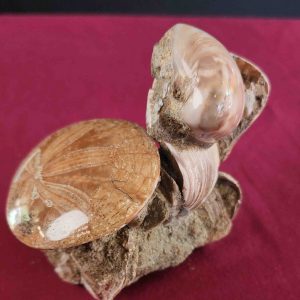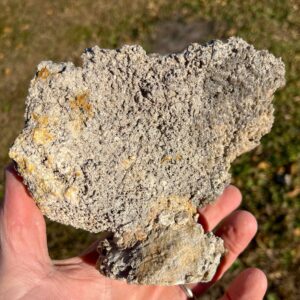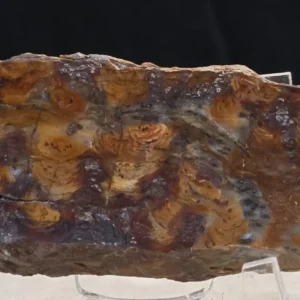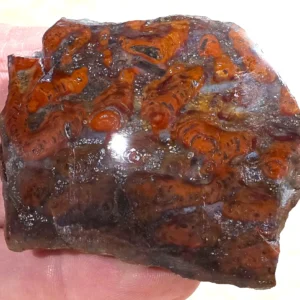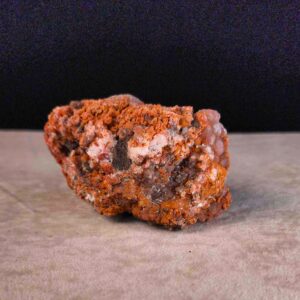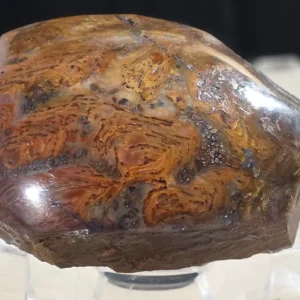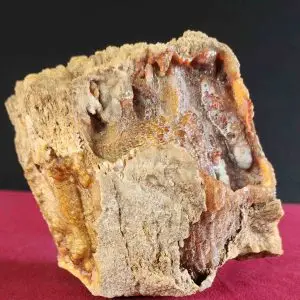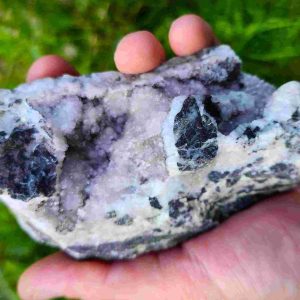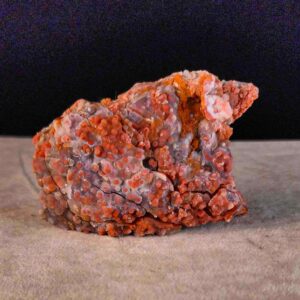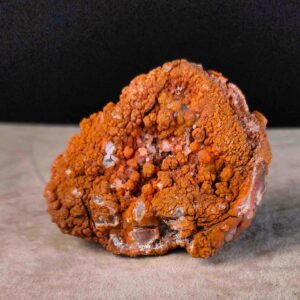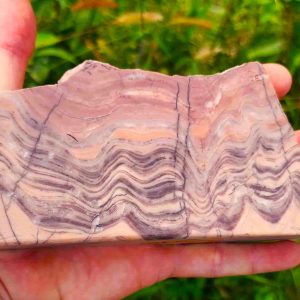All Products
-
Fossil Sand Dollar and Clam (KH6)
Notes specific to this specimen: Exquisite large brown polished sand dollar with two great polished clams and some unpolished clams beside them. This is a matrix piece that has a flat bottom so it stands up nicely.
SIZE: 4″x 3″x 3″
NAME: Psuedocardium & Dendraster
AGE: Pliocene 4 million years
UNIT: Etchegoin Formation
SITE: Kettleman Hills, CaliforniaDocuments: This authentic fossil specimen comes with a Certificate of Authenticity and Origin. In addition, an attractive and informative display card accompanies the specimen.
-
Agatized Coral (AC11)
Note: Beautiful carnelian agate. Segment of a large hollow piece with small flat bottom so it sits as shown.
SIZE: 6″x 7″
$85.00Agatized Coral (AC11)
$85.00 -
Rainbow Stromatolite (RS2)
Notes specific to this specimen: Another one of the original discovery pieces, collected by us in August 2025. Unusual wine coloring with distinct colonies.
SIZE: 1.5″x 4″x .5″
Name Collenia sp. (possible new species)
Age Anamikean / Paleoproterozoic – 1.88 billion years
Unit Gunflint Iron Formation
Site Ontario, Canada
Date 2025Documentation: This authentic fossil specimen comes with a Certificate of Authenticity and Origin. In addition, an attractive and informative display card accompanies the specimen.
$110.00Rainbow Stromatolite (RS2)
$110.00 -
Rainbow Stromatolite (RS3)
Notes specific to this specimen: Another one of the original discovery pieces, collected by us in August 2025. Deep red colonies surrounded by high iron hematite matrix.
SIZE: 2″x 2.58″x .75″
Name Collenia sp. (possible new species)
Age Anamikean / Paleoproterozoic – 1.88 billion years
Unit Gunflint Iron Formation
Site Ontario, Canada
Date 2025Documentation: This authentic fossil specimen comes with a Certificate of Authenticity and Origin. In addition, an attractive and informative display card accompanies the specimen.
$120.00Rainbow Stromatolite (RS3)
$120.00 -
Rainbow Stromatolite (RS5)
Notes specific to this specimen: Another one of the original discovery pieces, collected by us in August 2025. Wild contrasts in the colors of these colonies.
SIZE: 2″x 4″x .5″
Name Collenia sp. (possible new species)
Age Anamikean / Paleoproterozoic – 1.88 billion years
Unit Gunflint Iron Formation
Site Ontario, Canada
Date 2025Documentation: This authentic fossil specimen comes with a Certificate of Authenticity and Origin. In addition, an attractive and informative display card accompanies the specimen.
$150.00Rainbow Stromatolite (RS5)
$150.00 -
Agatized Algae (AA5)
Notes specific to this specimen: This is a piece of a much larger specimen. While it is not complete, the color and texture of this piece is very interesting. It retains some of the original 3-D shape, which is rare in this preservation environment.
SIZE: 5″x 2″x 2″
NAME: Undescribed species
AGE: Jurassic Period- 165 million years
UNIT: Curtis Formation
SITE: Emery County, Utah
DATE: 2010Documentation: This authentic fossil specimen comes with a Certificate of Authenticity and Origin.
$155.00Agatized Algae (AA5)
$155.00 -
Rainbow Stromatolite (RS4)
Notes specific to this specimen: Another one of the original discovery pieces, collected by us in August 2025. Unique honey-color colonies with unusual dark laminae. Never seen anything like this!
SIZE: 2″x 2″x .75″
Name Collenia sp. (possible new species)
Age Anamikean / Paleoproterozoic – 1.88 billion years
Unit Gunflint Iron Formation
Site Ontario, Canada
Date 2025Documentation: This authentic fossil specimen comes with a Certificate of Authenticity and Origin. In addition, an attractive and informative display card accompanies the specimen.
$165.00Rainbow Stromatolite (RS4)
$165.00 -
Agatized Coral (AC3)
Notes specific to this specimen: This is an exceptional and exquisite carnelian agate pair with rare fortified agatized cavities and preserved microscopic internal structures. This cut and polished pair is mounted on a pleasing piece of Suwanee Limestone – which is the matrix material these specimens originated from. No other preparator mounts these specimens on their native matrix. Honestly, most people don’t even know how they formed, much less know the association with Suwanee Limestone! You can see how translucent the hollows are – the carnelian agate just glows! Zoom in and look at the lighter colored sections below the hollow and you’ll see that it’s actually lace agate. We’ve never seen this before This is a one-of-a-kind beautiful pair!
SIZE: 9″x 4″x 5″
NAME: Several species
AGE: Oligocene Epoch- 34 million years
UNIT: Suwanee Limestone
SITE: Lowndes County, Georgia
DATE: 2021Documentation: This authentic fossil specimen comes with a Certificate of Authenticity and Origin. In addition, an attractive and informative display card accompanies the specimen.
$178.00Agatized Coral (AC3)
$178.00 -
Cerdito Prospect Rift Crystals (CP11)
Notes specific to this specimen: White druzy quartz with just a hint of purple dominates top of this specimen with some clear crystals as well. Sides show multiple healed fractures. Take a look at the cut bottom and you’ll see the very graphic splitting of the matrix and the subsequent infilling.
SIZE: 6″ x 3″ x 3″
Quartz – Amethyst, Smokey, Citrine, Clear
AGE: Mesoproterozoic Era – 1.1 billion years
UNIT: Rove Formation
SITE: Thunder Bay, Ontario, Canada
DATE: 2022Documentation: This authentic mineral specimen comes with a Certificate of Authenticity and Origin.
$180.00 -
Agatized Algae (AA3)
Notes specific to this specimen: This is a piece of a much larger specimen. While it is not complete, the color and texture of this piece is incredible. Beautiful, multicolored bubblegum agate all over it!
SIZE: 4″x 2″x 2″
NAME: Undescribed species
AGE: Jurassic Period- 165 million years
UNIT: Curtis Formation
SITE: Emery County, Utah
DATE: 2010Documentation: This authentic fossil specimen comes with a Certificate of Authenticity and Origin.
$185.00Agatized Algae (AA3)
$185.00 -
Agatized Algae (AA7)
Notes specific to this specimen: Small but complete algal ball – a round specimen with great bubblegum agate skin on the upper (convex) side and a nice multicolored carnelian agate underside (convex).
SIZE: 4″x 3″x 2″
NAME: Undescribed species
AGE: Jurassic Period- 165 million years
UNIT: Curtis Formation
SITE: Emery County, Utah
DATE: 2010Documentation: This authentic fossil specimen comes with a Certificate of Authenticity and Origin.
$185.00Agatized Algae (AA7)
$185.00 -
Kona Dolomite (KONA10)
Notes specific to this specimen: This is an excellent sliced section showing multiple stromatolite colonies with distinct layers (laminae). The clear layering is unusual for this slightly metamorphosed material. It has a smooth back and a flat bottom so it stands up nicely.
SIZE: 6″ x 3″ x 1″
NAME: Collenia kona
AGE: Paleoproterozoic Era 2.3 billion years
UNIT: Kona Formation
SITE: Kona Hills, Michigan
DATE: 2023Documentation: This authentic fossil specimen comes with a Certificate of Authenticity and Origin.
$185.00Kona Dolomite (KONA10)
$185.00

